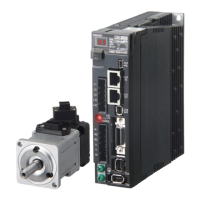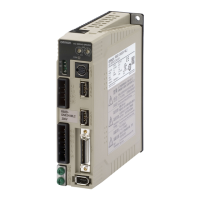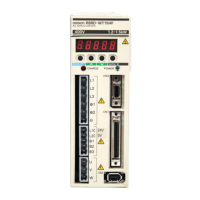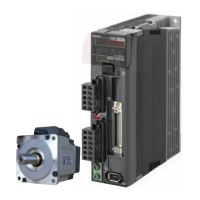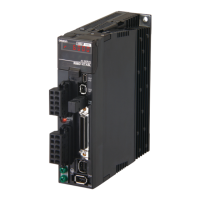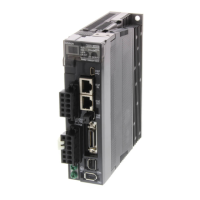11-24
11-4 Troubleshooting
OMNUC G5-SERIES AC SERVOMOTOR AND SERVO DRIVE USER'S MANUAL
11
Troubleshooting and Maintenance
The motor does not
rotate even if
commands are input
from the controller.
(Continued from
previous page)
The torque command is
disabled.
Check if the torque command input
method is correct.
Set the torque command
correctly.
The CW input and CCW input
are ON at the same time.
Check the command pulse's wiring.
·
Input the pulse signal either to the
CW input or CCW input.
· Always turn OFF the terminal
that is not input to.
The Servo Drive has broken
down.
− Replace the Servo Drive.
The Servomotor
operates
momentarily, but then
it does not operate
after that.
The Servomotor power cable is
wired incorrectly.
Check the wiring of the Servomotor
power cable's phases U, V, and W.
Wire correctly.
The encoder cable is wired incorrectly.
Check the encoder cable's wiring. Wire correctly.
The Servomotor
rotates without a
command.
The command pulse input is
incorrect.
Check the command pulse type.
Set the correct command pulse input.
Check the command pulse's voltage. Connect a resistor that matches
the voltage.
The Servo Drive has broken
down.
− Replace the Servo Drive.
The Servomotor rotates
in the reverse direction
from the command.
The CW input and CCW input
connections are reversed.
Check the controller's command pulse
type and the Servo Drive's command
pulse type.
Connect the CW pulse signal to
the CW input and the CCW pulse
signal to the CCW input.
Motor rotation is
unstable.
The Servomotor power cable or
encoder cable is wired
incorrectly.
Check the wiring of the Servomotor
power cable's phases U, V, and W and
check the encoder cable's wiring.
Wire correctly.
The coupling system between the
motor shaft and the mechanical
system has eccentricity or loose
screws, or the load torque is
fluctuating due to engagement
between pulleys or gears.
Check the mechanical system's coupling
section.
Review and adjust the machine.
Try rotating the motor without a load.
(Disconnect it from the mechanical
system.)
The load's moment of inertia
exceeds the Servo Drive's
allowable value.
Try rotating the motor without a load.
(Disconnect it from the mechanical
system.)
· Reduce the load.
· Replace the Servomotor and
Servo Drive with higher
capacity models.
The pulse signal line's
connections are loose.
Check the pulse signal line's wiring at the
controller and Servo Drive.
Wire correctly.
Check the controller's command pulse
type and the Servo Drive's command
pulse type.
Set the Servo Drive's pulse type
to match the controller's
command pulse type.
The gain is wrong. − Perform manual tuning.
The CN1 input signal is
chattering.
Check the operation command (RUN), error
counter reset (ECRST), zero speed
designation (VZERO), internally set speed
selection 1 (VSEL1) and internally set speed
selection 2 (VSEL2).
Wire correctly so that there is no
chattering.
The Servomotor is
overheating.
The ambient temperature is too
high.
Check that the ambient temperature
around the motor is 40°C or less.
Lower the ambient temperature
around the Servomotor to 40
°
C or
less. (Use a fan or air conditioner.)
Ventilation is obstructed. Check to see whether anything is
blocking ventilation.
Improve ventilation.
The Servomotor is overloaded. Try rotating the motor without a load.
(Disconnect it from the mechanical
system.)
· Reduce the load.
· Replace the Servomotor and
Servo Drive with higher
capacity models.
The Servomotor vibrates during
rotation.
Symptom Probable cause Items to check Measures

